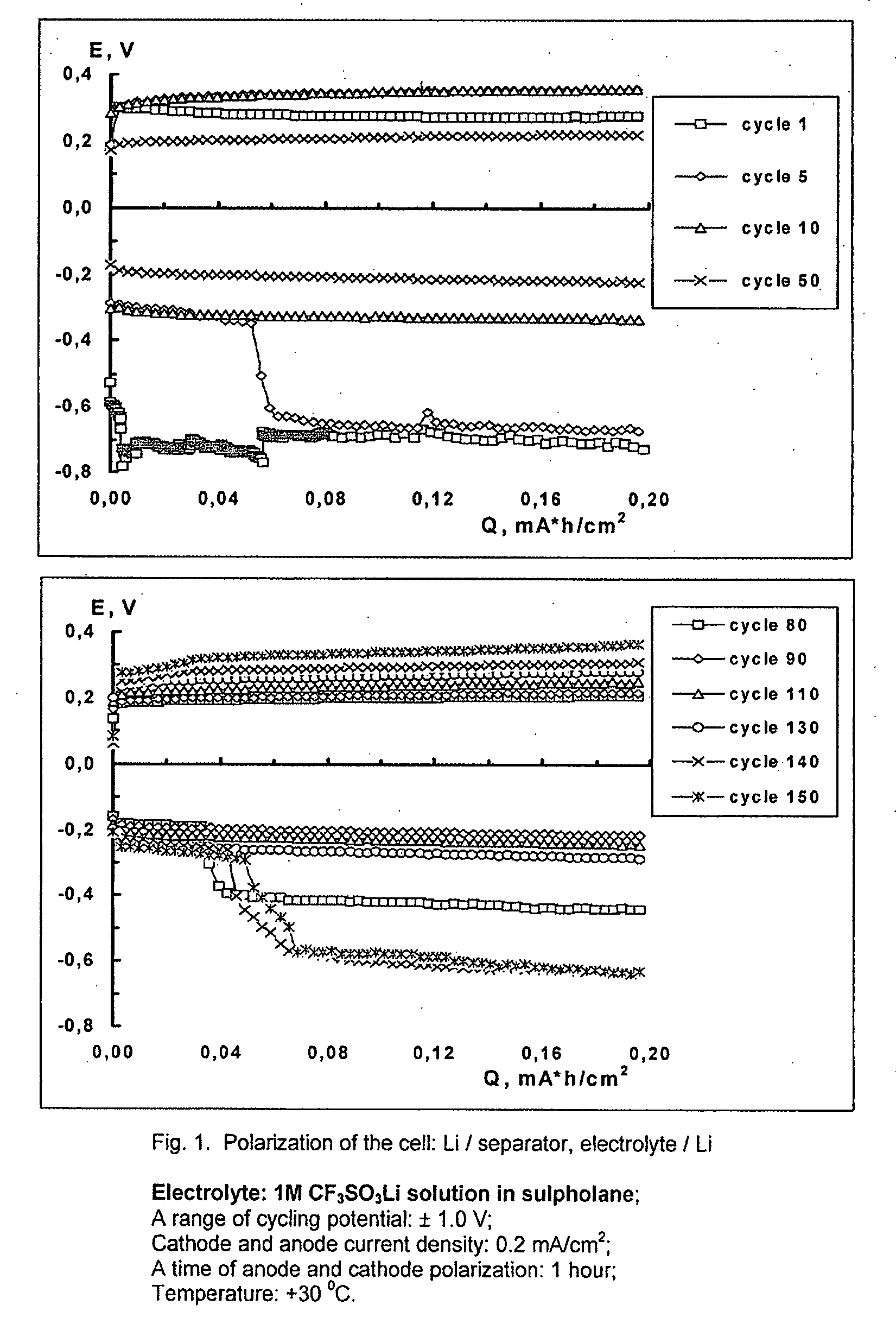Cell or battery with a metal lithium electrode and electrolytes therefor
a lithium electrode and metal technology, applied in the field of electrochemical power engineering, can solve the problems of short cycle life, non-thermal stability of electrochemical systems based on metallic lithium and non-aqueous electrolytes, and the inability to meet the requirements of electrochemical conditions, and achieve the effect of increasing the cycle life of lithium metal
- Summary
- Abstract
- Description
- Claims
- Application Information
AI Technical Summary
Benefits of technology
Problems solved by technology
Method used
Image
Examples
example 1
[0056]A cell was produced with two lithium electrodes, a separator Celgard 3501 (a trade mark of Tonen Chemical Corporation, Tokyo, Japan, also available from Mobil Chemical Company, Films Division, Pittsford, N.Y.), which was placed between the electrodes. The separator membrane was soaked with electrolyte before insertion into the cell. Lithium electrodes were produced from high purity lithium foil of 38 microns thickness (available from Chemetall Foote Corporation, USA). A copper foil was used as a current collector for the lithium electrodes. A 1M solution of lithium trifluoromethanesulfonate (available from 3M Corporation, St. Paul, Minn.) in sulfolane (99.8%, standard for GC available from Sigma-Aldrich, UK) was used as an electrolyte.
[0057]The cell was cycled on a battery tester Bitrode MCV 16-0.1-5 (Bitrode Corporation) at a current load of 0.2 mA / cm2. Cathode and anode polarization was undertaken for 1 hour each. The chronopotentiograms obtained during cycling of this cell ...
example 2
[0058](Preparation of Lithium Polysulfide Containing Electrolyte)
[0059]2 g of sublimated sulfur, 99.5% (Fisher Scientific, UK) and 0.57 g of lithium sulfide, 98% (Sigma-Aldrich, UK) were ground together in a high speed mill (Microtron MB550) for 15 to 20 minutes in an atmosphere of dry argon (moisture content 20-25 ppm). The ground mixture of lithium sulfide and sulfur was placed into a flask and 50 ml of electrolyte was added to the flask. A 1M solution of lithium trifluoromethanesulfonate (available from 3M Corporation, St. Paul, Minn.) in sulfolane (99.8%, standard for GC available from Sigma-Aldrich, UK) was used as the electrolyte. The content of the flask was mixed for 24 hours by using a magnetic stirrer at room temperature. This was a way of making a 0.25M solution of lithium polysulfide Li2S6 in 1M solution of lithium trifluoromethanesulfonate in sulfolane.
example 3
[0060]As described in Example 1, there was produced an electrochemical cell with two lithium electrodes separated by Celgard 3501 soaked with the electrolyte from Example 2.
[0061]The cell was cycled on an MCV 16-0.1-5 battery tester (Bitrode Corporation) at a current load of 0.2 mA / cm2. The time of cathode and anode polarization was 1 hour each. The chronopotentiograms obtained during the cycling of this cell are shown in FIG. 2.
[0062]A comparison of FIGS. 1 and 2 shows that addition of lithium polysulfide into the electrolyte composition leads to a more than threefold increase in the cycle life of a lithium electrode.
PUM
| Property | Measurement | Unit |
|---|---|---|
| pressure | aaaaa | aaaaa |
| temperature | aaaaa | aaaaa |
| temperatures | aaaaa | aaaaa |
Abstract
Description
Claims
Application Information
 Login to View More
Login to View More - R&D
- Intellectual Property
- Life Sciences
- Materials
- Tech Scout
- Unparalleled Data Quality
- Higher Quality Content
- 60% Fewer Hallucinations
Browse by: Latest US Patents, China's latest patents, Technical Efficacy Thesaurus, Application Domain, Technology Topic, Popular Technical Reports.
© 2025 PatSnap. All rights reserved.Legal|Privacy policy|Modern Slavery Act Transparency Statement|Sitemap|About US| Contact US: help@patsnap.com


